Report

At a Glance
- Italy’s current trajectory suggests it will miss 2030 climate targets and its goal for a net-zero future by 2050.
- Italy’s geographical vulnerability will result in approximately €10 billion in damages to strategic assets by 2050, intensifying the need for accelerated climate action.
- Only 15% of emissions created by Italian corporations are covered by science-based targets in line with the Paris Agreement.
- Strong governmental action in conjunction with a step change from the private sector towards decarbonization are needed to reach 2030 and 2050 targets.
The spotlight on nations’ commitments and progress towards the Paris Agreement goals has intensified ahead of the 2023 United Nations (UN) Climate Change Conference (COP28). This report examines Italy’s position in the global climate transition landscape, delving into the dual challenges and focal points of COP28: decarbonization and climate adaptation.
Italy’s climate threat heats up
Human-induced greenhouse gas (GHG) emissions have evolved from a disputed concern to a scientifically confirmed reality. A key indicator of this change is the global surface temperature, which has risen by 1.1 degrees Celsius since the onset of the industrial revolution in the mid-1800s. This rise has seen a notable acceleration since 1970. According to the Intergovernmental Panel on Climate Change (IPCC) Climate Change 2023 Synthesis Report, the primary drivers of increasing GHG emissions include unsustainable energy use, land use and land-use change, lifestyles and patterns of consumption and production across regions, between and within countries, and between individuals (see Figure 1).
The increase in GHG levels since the pre-industrial level has led to temperature increases

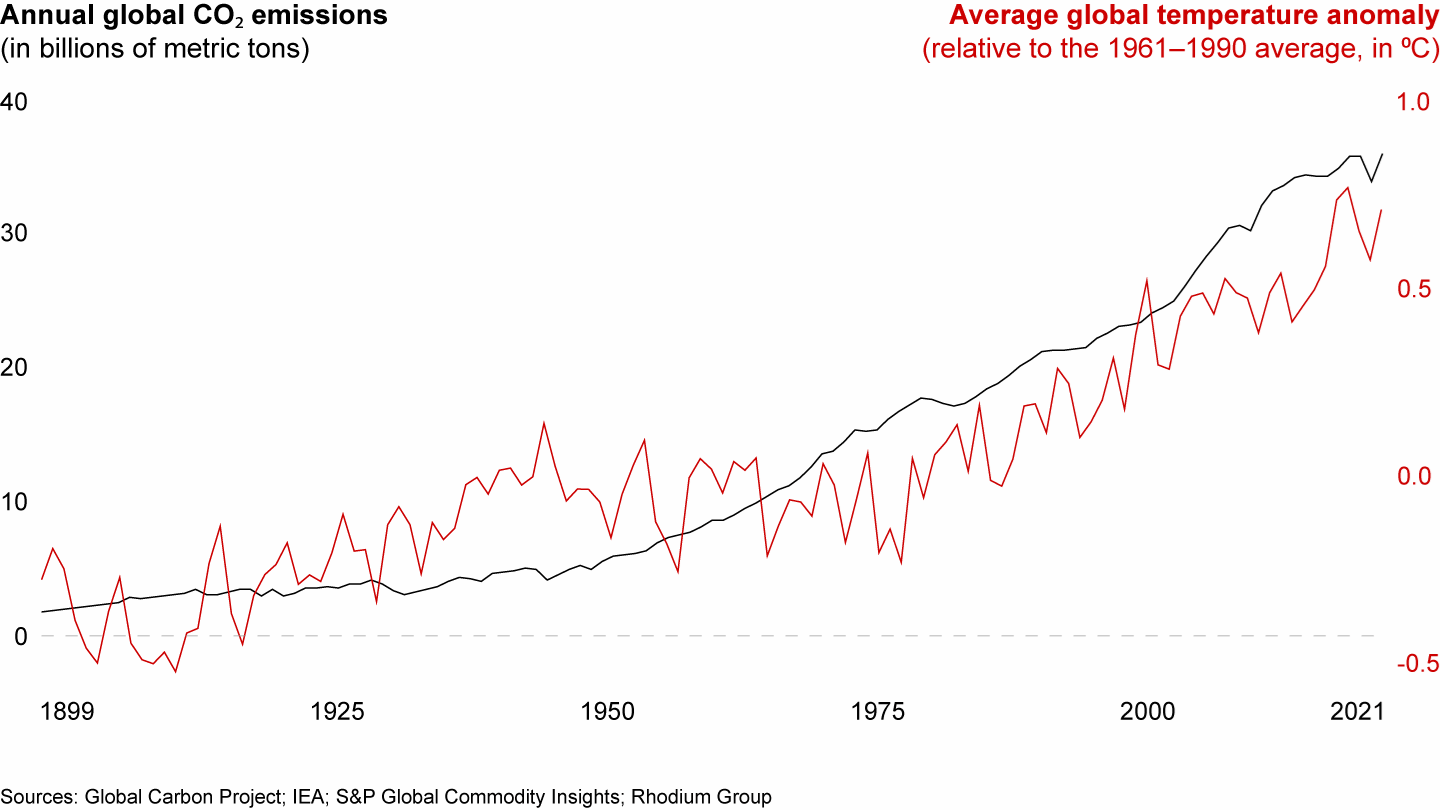
This escalation in climate change has led to more frequent and severe weather events worldwide. Italy stands out as a Mediterranean hot spot, a geographic area identified as particularly vulnerable and exposed to the risks of climate change. Widespread adverse impacts include major economic disruption and unrecoverable damage to nature and people.
Governments worldwide are recognizing the gravity of climate change and are taking measures to mitigate its effects. While communities that contribute minimally to climate change are most affected, developed nations like Italy are becoming increasingly exposed to high risk. If emissions remain unchecked, there is a concrete risk that global warming will surpass the hard adaptation limits.
Italy’s geographical makeup heightens its vulnerability to climate change. Over the past 30 years, Italy’s temperature has increased steadily, leading to more heat-related deaths and extreme weather events. A study by Bain & Company and partner Jupiter Intelligence found that 40% of Italy’s geography is at “high risk” of facing severe climatic events such as droughts, floods, and fires (see Figure 2).
60% of Italian territory is projected to be exposed to high physical risks by 2050

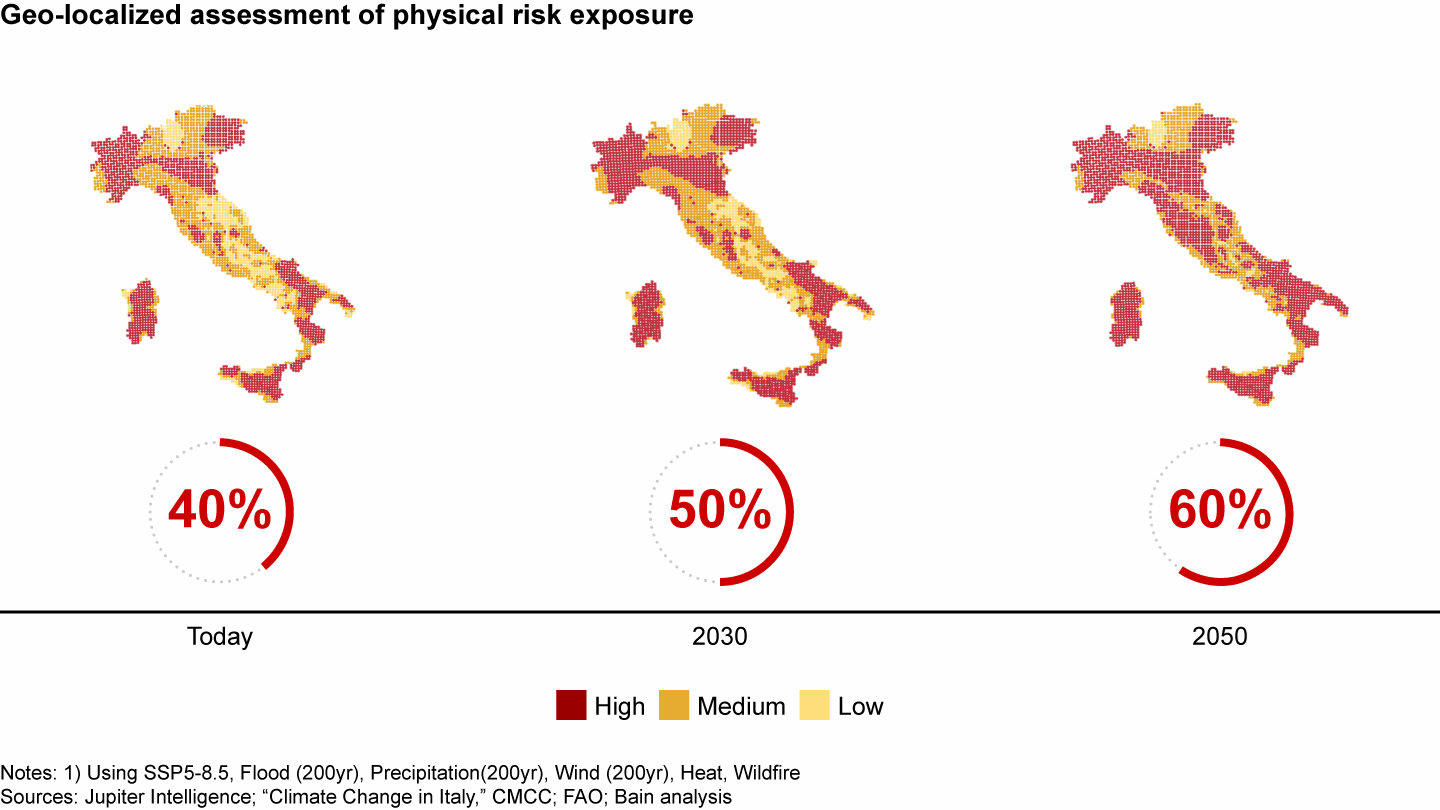
Since 1990, Italy has seen a surge in various climate perils, from heat waves to hailstorms, with the last decade witnessing a sharp increase in their frequency. For instance, Milan recorded 23 flash-flood events, while Rome reported 18. In May 2023, the northern Italian region of Emilia-Romagna experienced nearly 20 inches of rain in just 15 days (more than half of the region’s annual rainfall). This deluge led to the tragic loss of 15 lives, displaced thousands, and caused significant damage to productive activities, especially in farming, agriculture, and manufacturing. Approximately 238,000 fires burned around 2.6 million hectares across Italy, and throughout the summer of 2022, the Po River region grappled with a significant rainfall deficit, enduring over 100 consecutive dry days.
Extreme weather trends are expected to worsen throughout the entire peninsula, affecting Italy’s population, economy, and vital assets and sectors, such as energy, agriculture, water supply, and communication infrastructure. Bain research suggests that almost 70% (or €913 billion) of Italy’s strategic assets are at direct risk from climatic threats. If conditions deteriorate further, this exposure could rise to 80%, translating into potential annual damages of €10 billion.
If proactive measures aren’t taken, Italy could face widespread loss and damage. By 2050, an estimated 60% of its land could be at high risk, with around 16.5 million people (or 28% of the population) living in areas facing significant threats, according to Bain research. This scenario could result in a projected loss of €4.5 billion in agricultural productivity (see Figure 3).
Projected increase of high-risk land plus loss and damage for key assets and agricultural productivity

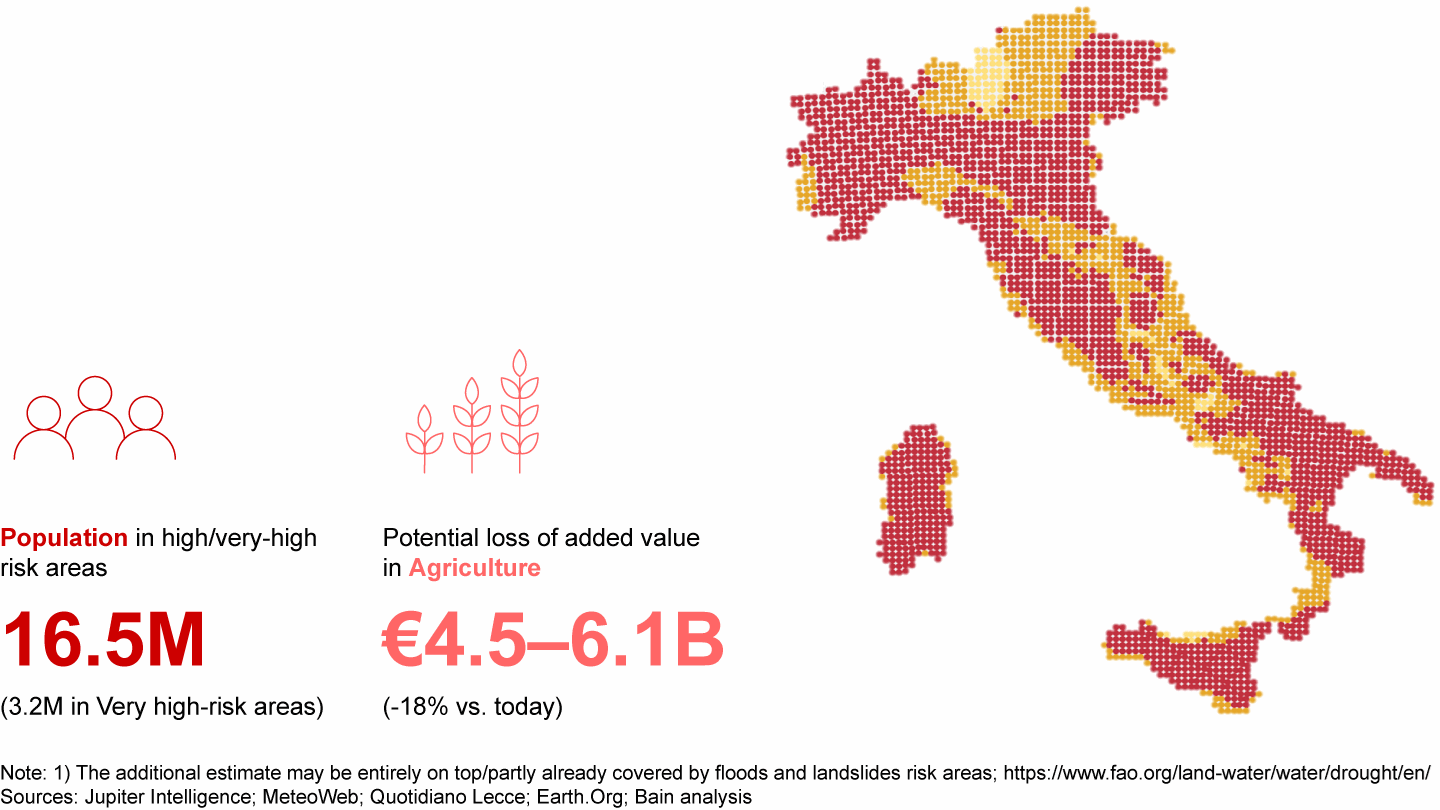
Global, EU, and Italian decarbonization and adaptation efforts
Adverse impacts of climate change can be limited by deep, rapid, and sustained global GHG emission reduction towards the net-zero target, according to the IPCC’s Climate Change 2023 Synthesis report. But there is a rapidly closing window of opportunity to limit temperature increase and secure a livable and sustainable future for the next generation.
Internationally, the UN Framework Convention on Climate Change (UNFCC) is making a pivotal effort in addressing climate change. Italy, as a signatory to the UNFCC’s Climate Change Conference (COP), committed to the Paris Agreement in 2016. This landmark treaty, endorsed by 196 nations, set the ambitious goal of capping global warming at 1.5 degrees Celsius above pre-industrial levels and achieving net-zero emissions by 2050. The COP’s dual objectives focus on both GHG emission reductions and temperature containment.
The European Union (EU) has been proactive, introducing a slew of regulations and earmarking over €800 billion for environmental and sustainability initiatives. Key among these are the Climate Framework (2020), the European Green Deal (2019), and the National Energy and Climate Plan (2019). Collectively, these measures target a 55% GHG reduction by 2030 and carbon neutrality by 2050. The “Fit for 55” legislative package further underscores the EU’s commitment to keeping global temperature rise below 2 degrees Celsius, while striving for the 1.5 degrees Celsius threshold.
The Italian government received €120 billion toward its own efforts to curb climate change. Under the guidance of UNFCC, participating countries are encouraged to develop a climate adaptation policy. The National Adaptation Strategy (NAS), a tool designed to facilitate the exchange of information between the central administration, local authorities, and citizens on climate adaptation, includes guidance on improving awareness, climate change data, and legislation transparency. The National Adaptation Plan (NAP), a national framework of guidelines for implementing measures to minimize climate change risks, is considered a key milestone for fighting climate change and improving adaptive capacity. Both are policy measures intended to be incorporated into regulatory frameworks.
Italy’s decarbonization targets are aligned to EU legislation; however, the latest target on Effort Sharing Regulation (ESR) emissions reduction for the period of 2021 to 2030, included in the EU Regulation 2023/857 (a reduction of 43.7%), has yet to be reflected in Italian policy, as current initiatives are not enough to achieve the target.
Italy struggles to meet its 1.5 degrees Celsius commitment
Total GHG emissions in Italy amount to 407 metric tons of carbon dioxide equivalent (Mt CO2e) or 371 Mt CO2e of net emissions, mainly driven by power generation, manufacturing and industrial processes, and transportation. According to our findings, business-as-usual scenarios project 336 Mt CO2e and 252 Mt CO2e in 2030 and 2050, respectively, which is far from the committed Paris Agreement targets.
To understand the likelihood of reaching net-zero targets, we identified an accelerated scenario, which would involve implementing several additional decarbonization levers, mainly in power generation, manufacturing, transportation, and the civil sector.
Key levers include making a shift in power generation sources, increasing renewable energy systems (ReS) capacity from approximately 41% to approximately 99% by 2050, and introducing new regulations around electrification and carbon capture usage and storage 2 (CCUS2) technology, which would likely lead to a GHG reduction rate of 87% in manufacturing and industrial processes. The transportation sector should increase electric penetration (approximately 80% by 2050) for road and rail transport, with 100% of oil replaced by biofuels, and it should increase sustainable aviation fuel (SAF) for aviation (approximately 60% by 2050) under EU ReFuel targets and replace some fossil fuels with biofuels by 2050. In the civic sector, residential and tertiary buildings would need to become more energy efficient overall, with restructuring annual rates expected to reach approximately 2.7% with approximately 75% of GHG saved. New construction emissions should be reduced by 40% by 2030 and by 100% by 2050.
Nevertheless, even in the accelerated scenario, we still project an approximately 76 Mt CO2e gap vs. net zero by 2050 (see Figure 4).
Even under an accelerated decarbonization scenario, Italy would still have a gap vs. the 2050 net zero target

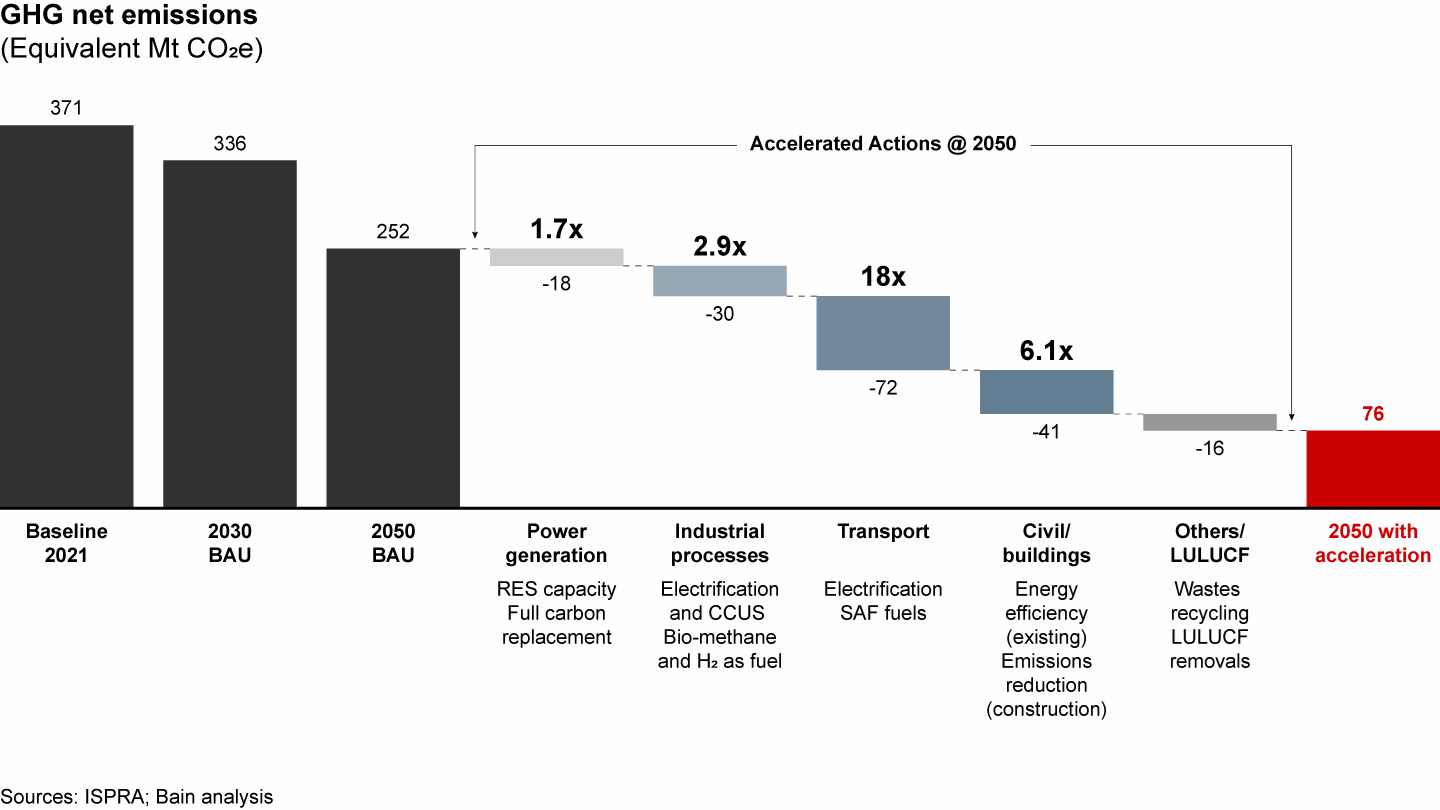
To understand the likelihood of the accelerated scenario, Bain conducted research to uncover how many corporate-driven GHG emissions (289 Mt CO2e in 2021) are disclosed by companies in Italy. The results showed that only approximately 26% of emissions (74.4 Mt CO2e) are publicly disclosed through the Carbon Disclosure Project (CDP), and just 15% (which corresponds to 298 companies) have set reduction plans in line with science-based target initiatives (SBTi) (see Figure 5).
Only 26% of Italian corporate emissions are reported through CDP, and only 15% refer to companies with science-based targets

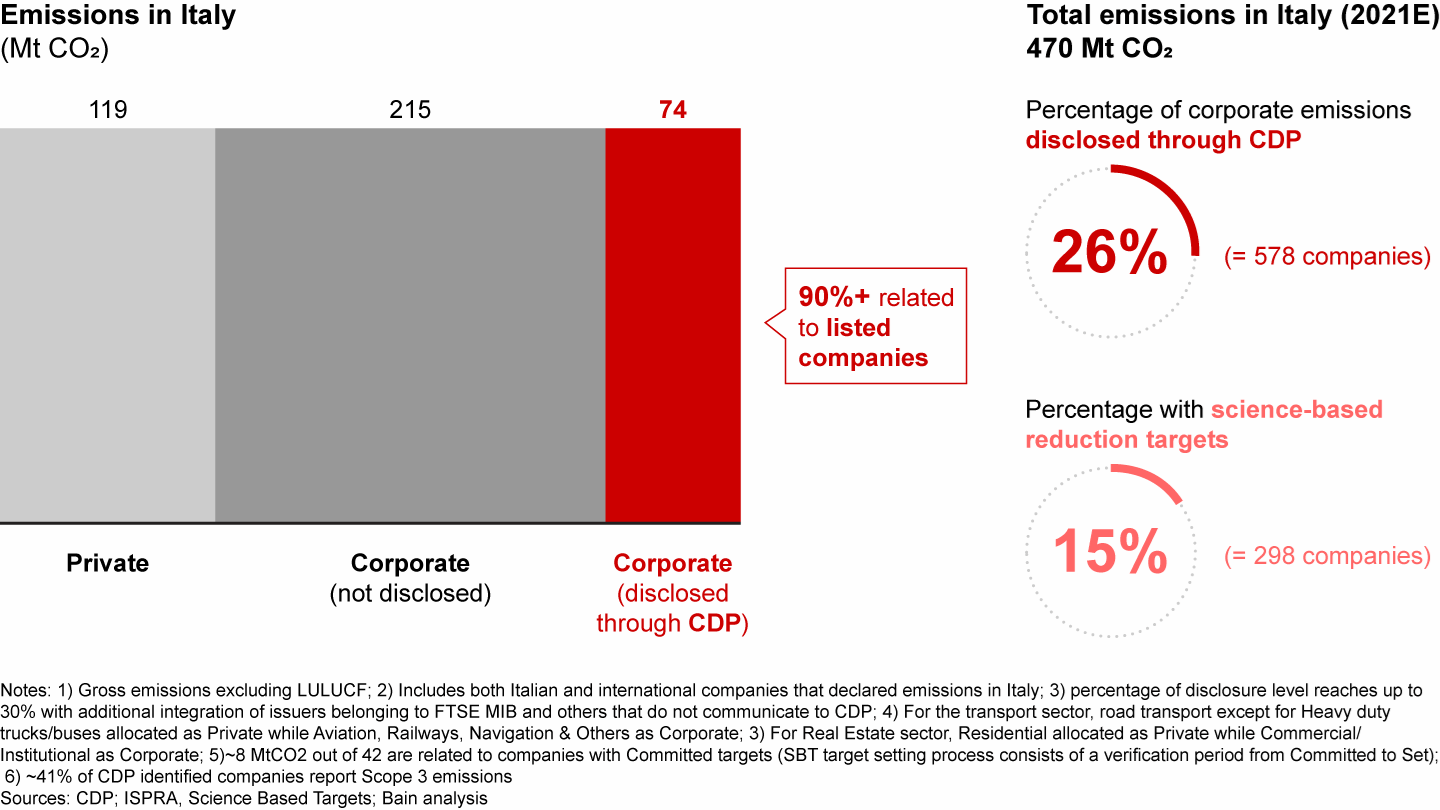
The analysis also shows that out of the total emissions covered by SBTi targets (15% of total corporate-driven emissions), 40% have both short-term (2030) and long-term (2050) targets, and 60% have only short-term targets.
We also identified uneven maturity levels of disclosure by sector. Power generation is the most transparent sector, with 63% of emissions covered by CDP. However, other industries, such as manufacturing and transportation, are much less transparent, with only 6% of emissions covered. The top 10 companies, mostly listed, declaring their emissions in Italy account for 80% of the total emissions declared to CDP.
Achieving Italy’s climate change commitments
We engaged 15 business leaders from major Italian companies to explore the country’s challenges in achieving its climate ambitions. These conversations yielded a wealth of insight into understanding the barriers that exist and actions that can be taken in the short and long term.
Executives highlighted the challenges and opportunities that Italy faces in achieving net zero by 2050. “Today’s courses of action are not the ones that will get us to net zero,” says the chief sustainability and innovation officer at a mobility company. “However, if there were correct incentives (funds, streamlined bureaucracy, tailor-made programs), the path towards net zero could certainly be accelerated.”
A multipronged approach is needed—involving businesses, governments, and individuals—working together to create a more sustainable future. Key insights include:
- Businesses play a key role in achieving net zero. They can do this by setting ambitious emissions reduction targets, investing in decarbonizing their operations, and working with their suppliers to decarbonize the value chain.
- The government also has a pivotal role to play in supporting businesses to decarbonize. This can be done through policies, regulations, and efficiently deployed financial incentives.
- Small and medium-sized enterprises (SMEs) face particular challenges in decarbonizing their operations. They often lack the resources and expertise to make the necessary changes. Governments and businesses can help SMEs by providing them with financial assistance, training, and technical support.
Climate adaptation is as important as decarbonization. Businesses need to take steps to protect their assets and infrastructure from the impacts of climate change.
There is awareness of the issue, and willingness to comply exists, but many companies say that cost and complexity hinder compliance. “ESG [environmental, social, and governance] targets are important … however, the first criteria we look at is the economic return on investment,” an executive at a wind power company explains. It takes a lot of resources to develop and implement an effective data monitoring system necessary to achieve targets. The costs of reducing Scope 1 and 2 emissions are substantial, and the challenges of Scope 3 emissions are even greater.
The overriding message that emerged from our research and conversations was that Italy must considerably accelerate its efforts more than others to catch up and accomplish its commitments. This will require a combination of government policies and corporate action. Governments need to create a clear regulatory framework that incentivizes companies to reduce their emissions. Companies need to invest in new technologies and practices that will help them reduce their emissions.
Bold actions to make climate ambitions achievable
Achieving net-zero targets is a challenging task but might be possible by balancing financial and regulatory support. If Italy’s public and private sectors can cooperate, the country has a better chance of achieving its climate change ambitions. As a result of our research and the conversation with business leaders, we identified eight pragmatic calls to action to accelerate the decarbonization path in Italy (see Figure 6).
Through interviews with Italian business leaders, we identified eight pragmatic calls to action to accelerate Italy’s climate transition

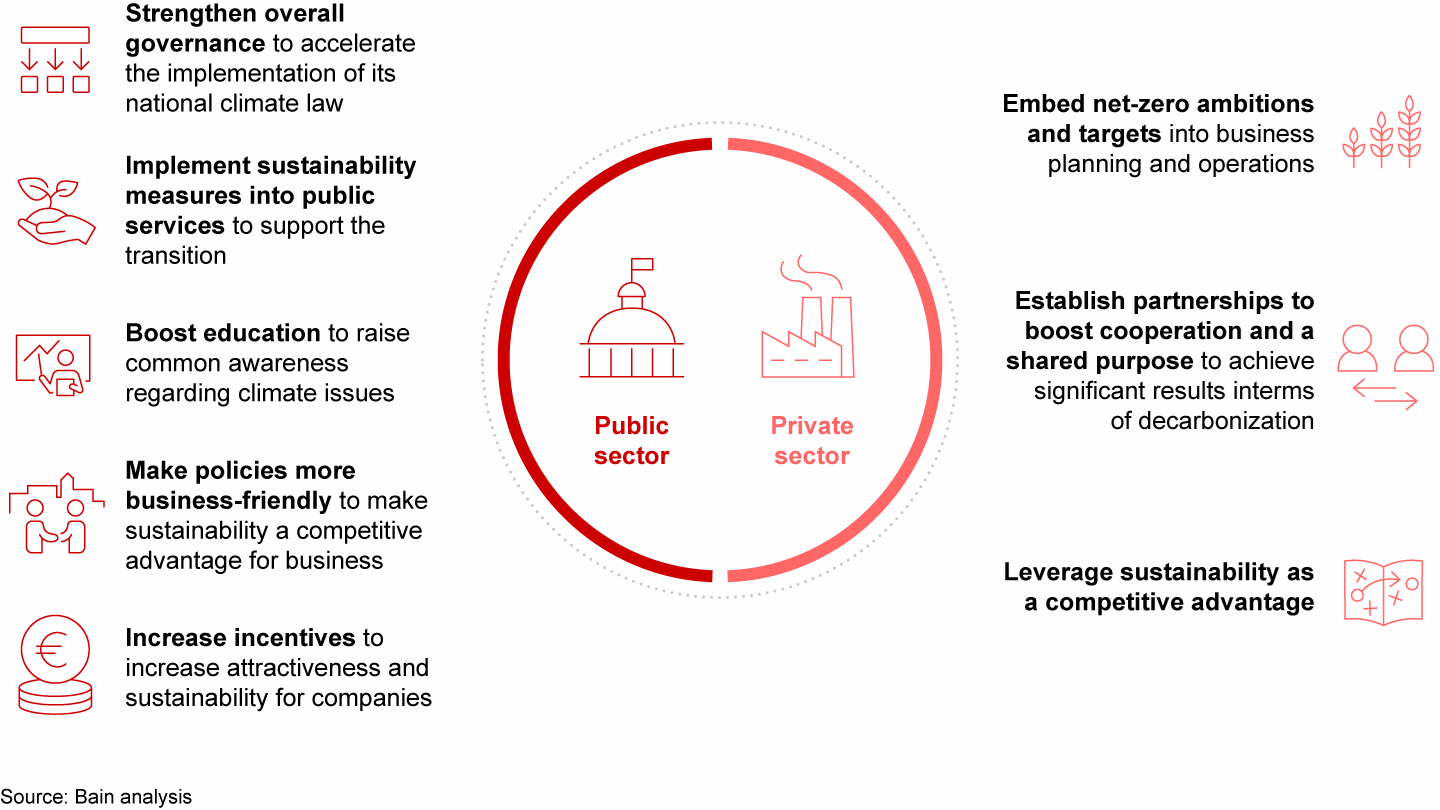
Actions for Italy’s public sector
Strengthen overall decarbonization governance. Accelerating the implementation of Italy’s NAP would be a solid first step and should include a review of the 361 infra-sectoral measures that currently have no clear ownership or monitoring system. Developing new strategies, policies, frameworks, and regulations to guide actions and monitor progress will reduce inefficiencies. Establishing clear guidelines and standards will also enable the government to focus attention on the most vulnerable areas and support an environment that encourages businesses to adopt sustainable practices.
“Institutions can help by setting policies that encourage the use of renewable energy by providing incentives for businesses to reduce their carbon footprint,” says the CEO of an Italian engineering firm. If companies want to encourage action and deter inaction, they might consider implementing both incentives and penalties. For instance, if the goal is to boost contributions and reduce inefficiencies, institutions could consider introducing legislation that offers rewards or imposes stricter controls like fines, penalties, or taxes.
Implement sustainability measures in public services. Italy can scale up the decarbonization of its supply chains by facilitating emissions reductions through shifts from road to rail for both passenger and freight transport. Developing the required infrastructure to support this switch, such as enhanced railways, is crucial. Rapidly electrifying and developing reliable public transport with renewable-generated sources would reduce air pollution in cities, emissions, and the need to import oil. Italy contains some of Europe’s best geographical conditions for solar energy. By leveraging this potential, the country can reduce its dependence on fossil gas, which generates almost 50% of its electricity.
Educate the public on climate change. According to the UN, education is a critical agent in addressing the issue of climate change. The Italian government can integrate climate science into its core education to further legitimize climate mitigation and adaptation efforts and adequately support initiatives for green professional development (academies). Education can encourage people to change their attitudes; it also helps them make informed decisions. The UN’s Action for Climate Empowerment (ACE) can empower the public to engage in climate action through education and training. “A country that does not prepare the necessary skills is shortsighted,” says an executive at an infrastructure services company. “In Italy, there are only 28 scientific high schools addressing energy transition.”
Make policies more business-friendly. The public perception of the green transition can feel like one more thing for which to be penalized. Shifting that mindset from compliance to competitive advantage—one that aims to encourage, not penalize—will help the government gain support for its efforts. One way to achieve this is by directing public investments toward the development of new sustainable industries, turning them into lucrative opportunities for businesses. Additionally, given the significant expenditure by the public sector, integrating sustainability criteria into public procurement processes can further incentivize businesses to adopt greener practices. “It’s important for the public sector to provide more incentives in procurement processes to reward suppliers that offer solutions with the lowest emissions impact,” an executive at a civil engineering and construction company explains. “Encouraging sustainable practices in bidding processes can create a positive market environment and drive companies to innovate and adopt low-carbon technologies.” By setting clear corporate technical targets for corporations and streamlining bureaucratic processes, the government can catalyze the creation of new supply chains (new raw materials, technologies), making sustainability a competitive business strategy.
While public funds are available, the deployment of these resources is hindered by complex bureaucratic processes. Simplifying these procedures, especially for SMEs, and increasing transparency, availability, and support could bridge this gap and enable more projects and companies to access funds.
Increase incentives. The current distribution of incentives predominately benefits larger corporations. While it is important for large enterprises to lead the way, a more balanced approach is needed. SMEs typically lack the economic resources to support transition investments, so incentives, like tax breaks, can help. “In Italy, it’s particularly important to focus on assisting SMEs,” says the executive at the civil engineering and construction company. “These businesses are the backbone of our economy; however, the current distribution of incentives predominantly benefits larger corporations.” Policy can help guide SMEs, and the Italian government can adopt legislation that encourages sustainable processes that create a positive market environment and drive companies to innovate and adopt low-carbon technologies. For example, more incentives to reward lower-emission suppliers in the procurement process will ultimately lower emissions. Incentives can also help support the development and scale-up of technologies, which are typically not economical in their early stages.
Actions for Italy’s private sector
When we asked about the major source of failure to set credible emission reduction plans, many CEOs cited potential costs and risks as an overriding concern. Others responded that many companies lack the necessary data and tools, especially SMEs. Inadequate expertise or resources to develop and implement effective emission reduction plans were also mentioned.
Embed net-zero ambitions into business planning and operations. First, businesses need to integrate sustainability and net-zero targets into their core business strategy. This means setting ambitious goals where every business decision is made with these targets in mind. Companies face significant challenges in translating overall decarbonization goals into specific targets for their different business units, markets, and brands. Those reporting success are taking a top-down approach, creating business plans that consider the potential impacts of climate change, and integrating risk assessments into decision-making processes.
“Reporting is essential because it obliges companies to measure and makes clear what should be measured,” says an executive at an infrastructure services company. “While it is a complex exercise, it helps illuminate places where companies can make improvements.”
At a civil engineering and construction company we spoke to, emission reduction targets are incorporated into the long-term incentive plan for its top management. Robust calculation and reporting capabilities enable them to establish those targets. “We approve a climate transition roadmap,” explains the CEO. “We use this roadmap to identify best practices, conduct cost-benefit analyses, and strive to replicate these practices across the company.”
The private sector can accelerate its efforts by imposing stricter requirements on suppliers and adding ESG criteria and disclosure requirements for potential vendors. “Enhancing sustainability requirements in the procurement of products and services by considering their entire life cycle ensures that environmental impacts aren’t inadvertently shifted to different stages of the life cycle,” explains the CEO of an engineering firm.
Extending beyond the impact of direct operations, Italian companies seek to create a more sustainable supply chain. To address Scope 3 decarbonization efforts, the engineering firm CEO says they are playing an active role in supporting and encouraging all the players in the value chain to reduce their carbon footprint, with actions in the supply chain like the adoption of an ESG platform to monitor the sustainability performance of its vendors at an advanced level.
Incentivize partnerships. Decarbonization requires cooperation and a shared purpose to achieve significant results. In industries like energy, collaboration along the value chain is important. Every stakeholder has a role to play. Partnerships are not just about shared responsibilities, but also about pooling resources to develop critical technologies. Shared investments in research, technology development, and infrastructure can accelerate the pace of change, allowing for the deployment of sustainable solutions.
Alliances and partnerships are increasingly focusing on achieving SBTi targets. According to the CEO of an engineering firm, they contribute to decarbonization through its value chain. “On one hand, we give our clients innovative solutions and technologies,” they explain. “On the other, we actively engage with suppliers.”
To emphasize the commitment, the company created internal incentive schemes to reward progress and invited more than 300 strategic vendors to a dedicated event that introduced the company’s sustainable supply chain strategy. Central to this strategy is their carbon tracker platform, an advanced industry platform that allows vendors to obtain a free-of-charge reliable calculation of their corporate GHG emissions. The platform’s advanced functionalities allow the company to manage reduction initiatives with key vendors and to track the carbon footprint of its supply chain to provide greater transparency.
Leverage sustainability as a competitive advantage. Customers are increasingly demanding sustainable products and services, and embracing sustainability can be a significant differentiator. Companies that position themselves as sustainable businesses not only attract institutional investors who prioritize long-term returns and business continuity but also appeal to a growing consumer base that values environmental and social responsibility. This commitment can enhance a company’s reputation, attract investors, and foster long-term growth. Sustainability also is becoming a pivotal lever to attract and retain top talent, especially among younger generations who prioritize working for environmentally conscious employers. Companies can also invest in climate initiatives by accessing debt to finance new investments for climate adaptation and interventions for at-risk sectors.
SMEs, whose primary focus is to remain competitive within their respective value chains, should recognize the increasing pressure from their larger buyers to adopt sustainable practices. This push, often driven by the large corporations’ goals to reduce their Scope 3 upstream emissions, means SMEs need to adapt. It’s important for these SMEs to integrate sustainable strategies during prosperous times, leveraging periods of growth to effectively explore and implement sustainable changes.
Italy’s climate imperative
The evidence is clear. Current efforts fall short of Italy’s commitments to combat the escalating threats of climate change. Our research suggests that Italy will not meet its 2030 targets nor its goal of hitting a net-zero future by 2050. It’s also lacking strategies and plans to course-correct and avoid this peril.
The challenges Italy faces are significant, but not insurmountable. The nation’s public and private sectors, along with its citizens, need to recognize the gravity of the situation and collectively begin enacting changes. For the public sector, this means accelerating the implementation of national climate initiatives, investing in sustainable infrastructure, and integrating sustainability criteria into public procurement processes. For the private sector, it involves embedding net-zero ambitions into business planning, leveraging sustainability as a competitive advantage, and fostering partnerships to drive innovation.
Companies, both large and small, must recognize the increasing demand from consumers, investors, and society for sustainable products and practices. By embracing sustainability, companies can reduce their emissions and attract investments, tap into new markets, and retain top talent.
Timely and strategic interventions will be necessary to safeguard Italy’s future and uphold its global commitments.